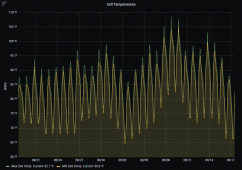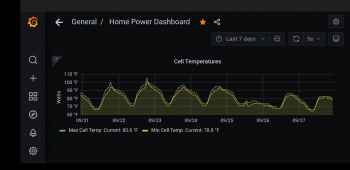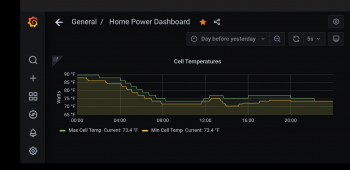I know your battery cabinet is out in the sun, but how hot is it really getting? How much current are you running in and out of the batteries? Mine do not seem to be making any heat at all. How much power is the chiller going to need?
It was a little cooler here today, we got down into the 50's overnight, and just hit low 90's for the high. My battery temp never got over 23C or just 73.4 F as the outside air hit 90, and it was about 82 or so in my garage where my batteries are. With the second pack connected (a total of 4 x 3P strings now) my maximum current per string is under 25 amps discharging. And charging is way less than that now at less than 11 amps per string, even with the worst case imbalance I have seen.
I don't mean to hijack your thread, but I figured you would find this interesting...
I did a little test of the voltage drops under current today. The new battery bank is showing about 20% less series resistance. It appears most of the is the BMS, but some must also be in the actual cells. My old pack is sharing the single 200 amp rated JK-BMS which is measuring about dead on 0.001 ohm or 1 milliohm. In the new pack, each of the two 3P strings has it's own 100 amp rated Daly BMS. While each one is measuring about 1.2 to 1.3 milli Ohms ( about 0.00125 ohms), the two in parallel are measuring less drop than the JK-BMS, and calculating out to just 0.0006 ohms (0.6 milli Ohms). The total cable and fuses etc. are all about the same as the original pack, but it does also have two shut off switches in parallel, so that may also reduce the voltage drop a little as well. As the system has been cycling for 3 days now, the new pack is pulling a little more current in both directions, so it is not a balance issue. Th new pack has a little more capacity, and a little less series resistance.
Admittedly, my clamp on amp meter is not the most accurate at lower currents, but I repeated th measurements, and even flipped the jaw around to read them as negative current as well to reduce any offset effects. At a 27 amp total charge current, the old battery bank was only taking 12 amps, while the new battery bank was taking 15 amps. The is a significant difference. At that moment, the new battery bank was puling 25% more of the current than the old battery bank. WOW! With the longer cable run, I really expected the new pack to take less of the power. I wonder how much of this is the fact that the new bank maybe has 5 cycles, while my old pack has over 300 40%-50% cycles? The old cells are LG Vista 2.1 and the new ones are LG GEN 2.2 and they are 1/16th of an inch longer. I have commented on a few threads about parallel operation of non matching batteries. I knew the different version and age would cause a little imbalance in the current, but this is a bit more than I was expecting. It will not cause any problem in my system. My voltage and state of charge range is well within the safe area, and even just a single string (I have 4 now) can actually handle the maximum current I am running, for both charge and discharge. So there is not worry about over stressing any of the cells.
At my new lower charge cutoff, the JK-BMS reported the cells only charged to 87% which does sound about right for 4.05 volts per cell. The inverter just cut off at my new raised lower limit of 53 volts (3.786 volts per cell) and the JK-BMS is showing that as 74% remaining, so I only pulled 13% out of the old battery bank. That is a small cycle. It shows the pack still having 267 amp hours remaining, and the numbers work out correct. The battery bank charged for 6 hours and 6 minutes, or 6.1 hours, at 27 amps. That works out to 164.7 amp hours. Only 46.8 amp hours came out of the old battery, so the new one supplied 117.9 amp hours. The new pack took 72% of the energy?? Wow. That is certainly way more off balance than I was expecting. I will have to track a few more cycles. It is not helping that the new Daly BMS units don't have any smart monitoring, so I am having to use the data from the Schneider XW-Pro and just subtract out what the old battery is doing. I think the Schneider may be over reporting a little. But I doubt it could even be 5% too high. So I really do believe my new battery bank is taking close to 70% of the energy transfer. And the new cells also seem to have a more efficient charge/discharge efficiency. I am getting more of the amps hours that I put in, back out. The old bank may also be doing better, since the current is now less than half what it was.





